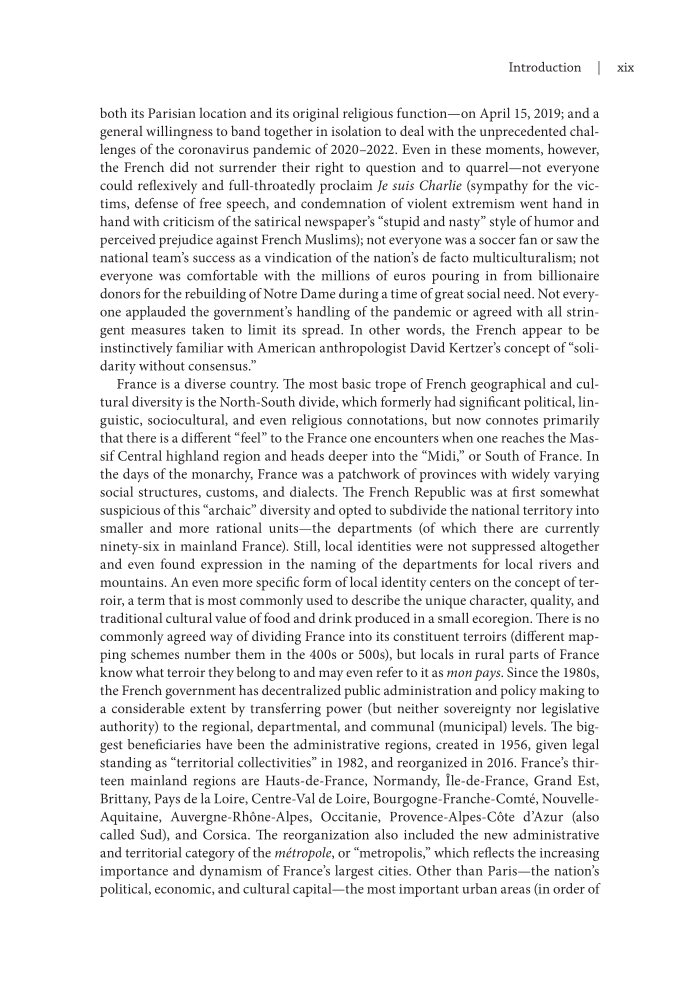Introduction | xix both its Parisian location and its original religious function—on April 15, 2019 and a general willingness to band together in isolation to deal with the unprecedented chal- lenges of the coronavirus pandemic of 2020–2022. Even in these moments, however, the French did not surrender their right to question and to quarrel—not everyone could reflexively and full-throatedly proclaim Je suis Charlie (sympathy for the vic- tims, defense of free speech, and condemnation of violent extremism went hand in hand with criticism of the satirical newspaper’s “stupid and nasty” style of humor and perceived prejudice against French Muslims) not everyone was a soccer fan or saw the national team’s success as a vindication of the nation’s de facto multiculturalism not everyone was comfortable with the millions of euros pouring in from billionaire donors for the rebuilding of Notre Dame during a time of great social need. Not every- one applauded the government’s handling of the pandemic or agreed with all strin- gent measures taken to limit its spread. In other words, the French appear to be instinctively familiar with American anthropologist David Kertzer’s concept of “soli- darity without consensus.” France is a diverse country. The most basic trope of French geographical and cul- tural diversity is the North-South divide, which formerly had significant political, lin- guistic, sociocultural, and even religious connotations, but now connotes primarily that there is a different “feel” to the France one encounters when one reaches the Mas- sif Central highland region and heads deeper into the “Midi,” or South of France. In the days of the monarchy, France was a patchwork of provinces with widely varying social structures, customs, and dialects. The French Republic was at first somewhat suspicious of this “archaic” diversity and opted to subdivide the national territory into smaller and more rational units—the departments (of which there are currently ninety-six in mainland France). Still, local identities were not suppressed altogether and even found expression in the naming of the departments for local rivers and mountains. An even more specific form of local identity centers on the concept of ter- roir, a term that is most commonly used to describe the unique character, quality, and traditional cultural value of food and drink produced in a small ecoregion. There is no commonly agreed way of dividing France into its constituent terroirs (different map- ping schemes number them in the 400s or 500s), but locals in rural parts of France know what terroir they belong to and may even refer to it as mon pays. Since the 1980s, the French government has decentralized public administration and policy making to a considerable extent by transferring power (but neither sovereignty nor legislative authority) to the regional, departmental, and communal (municipal) levels. The big- gest beneficiaries have been the administrative regions, created in 1956, given legal standing as “territorial collectivities” in 1982, and reorganized in 2016. France’s thir- teen mainland regions are Hauts-de-France, Normandy, Île-de-France, Grand Est, Brittany, Pays de la Loire, Centre-Val de Loire, Bourgogne-Franche-Comté, Nouvelle- Aquitaine, Auvergne-Rhône-Alpes, Occitanie, Provence-Alpes-Côte d’Azur (also called Sud), and Corsica. The reorganization also included the new administrative and territorial category of the métropole, or “metropolis,” which reflects the increasing importance and dynamism of France’s largest cities. Other than Paris—the nation’s political, economic, and cultural capital—the most important urban areas (in order of
Document Details My Account Print multiple pages
Print
You have printed 0 times in the last 24 hours.
Your print count will reset on at .
You may print 0 more time(s) before then.
You may print a maximum of 0 pages at a time.




























































































































































































































































































































































































































































































































































